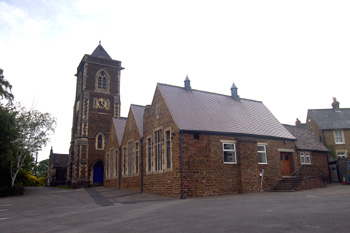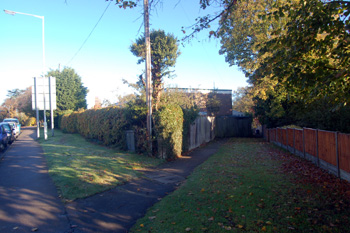Public Education in Linslade Before 1965
To piece together the history of schools in Linslade from sources at Bedfordshire & Luton Archives & Records Service is not easy as until 1965 Linslade was in Buckinghamshire, the school records are thus with the Centre for Buckinghamshire Studies. The best one can do is to look at directories, censuses and secondary sources.

Saint Barnabas church and former National School June 2008
Linslade National or Parochial School, later Public Elementary School
Sources conflict as to the construction date of this school, which was adjacent to Saint Barnabas church and survives as the Church Hall. It was built either in 1842, at a cost of £965, as stated in Kelly's Directory or in 1849 as stated in secondary sources about the church. It is unclear whether it was a school which was in union with the National Society or simply a Church of England school which followed the principles of the Church and Society. Later 19th century directories state that it housed 100 girls and 90 infants, whilst earlier directories state that it had also originally taught boys but that these moved to a new site in Stoke Road 1874.
The Education Act of 1902 abolished National and other wholly run church schools, replacing them with Public Elementary Schools which were partially under the control of the newly formed Local Education Authority which, for Linslade at this date, was Buckinghamshire County Council. In 1913 the girls were sent to the old Boys School premises in Stoke Road leaving the school as a Public Elementary Infants School for 130 children.
Directories and censuses list the following teachers:
1850: Isaac Parker, master; Caroline Parker, mistress;
1851: Isaiah Preston, master; Caroline S.Preston, mistress;
1871: Charles Henry Hanmer, master; Miss Ann Elizabeth Bonaker, mistress;
1883: Miss Alice Hart mistress; Miss Elizabeth Botsford mistress;
1891: Miss Kezia Bunnell, mistress; Miss Ann Richardson and Miss Annie Hodgkiss, assistant mistresses;
1899: Miss Kate Bulmer mistress; Miss Elizabeth Botsford infants mistress;
1920: Miss Dorothy Greenway, mistress.

Site of former Boys' Board School at the junction of Stoke Road and Bossington Lane October 2008
Linslade Boys Board, later Council School
A School Board was formed in Linslade in 1871 and in 1874 the Linslade School Board built a Board School for Boys at the entrance to Bossington Lane in Stoke Road and enlarged it in 1893. It is here that the boys from the National School were transferred.
The 1902 Education Act abolished Board schools as well as National schools, the Board schools becoming Council Schools under the control of the Local Education Authority. In 1913 the site was taken over by girls and the boys moved to new premises in Leopold Road.
Directories list William Carter as headmaster between 1877 and 1899.

The former Linslade Boys Council School October 2008
Linslade Boys Council School
This school was built in Leopold Road in 1913 and the boys from Stoke Road transferred to it. The old buildings are still extant and now used by the younger children of Linslade Lower School, the older children being housed in newer buildings on the site.
Directories list Frederick Wood as headmaster between 1915 and 1920.
Linslade Girls Public Elementary School
In 1913 the girls were moved from the Saint Barnabas site to the former Boys Council School premises in Stoke Road. Kelly's Directory lists Miss Kate Bulmer as the mistress in 1920.
Education Act 1944
The Education Act of 1944 established the principle of County Primary Schools for children up to the age of 11, at which time they took an examination to determine the nature of the secondary school they would attend until they were 15, the most academically able going to grammar schools, the rest to secondary or secondary modern schools. The act also created two types of successor to the public elementary schools - the Voluntary Aided and Voluntary Controlled schools.